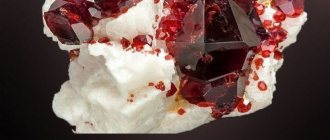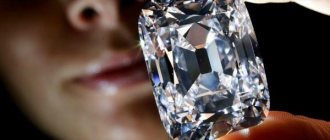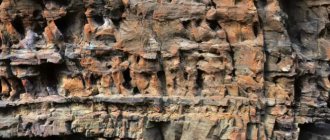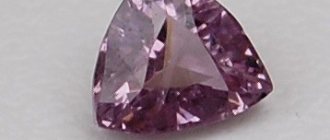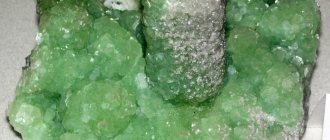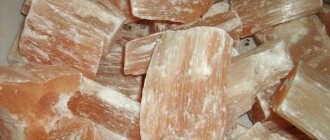Flint is a natural mineral based on chalcedony. It is not a precious stone and is similar in appearance to an ordinary cobblestone.
ATTENTION! If a person wears an imperial amulet on himself, he will never be poor. His debts are closed and a streak of luck sets in, which brings him into a comfortable life. With an imperial amulet, money will come in abundance - there will be much more of it than you expect... Read more"
The stone is very common and is found everywhere. However, healers often paid attention to the special healing properties of flint; they used it to make fire and use it to make tools and hunting devices. Silicon, a chemical element, should be distinguished from it.
Story
The fact that primitive man survived the confrontation with natural elements and predators is largely due to flint.
This pebble became the first tool for making fire; scrapers, drills, needles, and arrowheads were also made from it. Tribes leading a primitive way of life in the wilds of Africa or the Amazon still use them today.
Flint flint served as the “trigger” of firearms until the 19th century.
It is no coincidence that the name of the stone comes from the ancient Greek “kremnos”, which means “to burn”.
The millstones of hand and mechanical mills were also made of flint.
By hitting pebbles one against the other, you can create a spark. Modern children amuse themselves with them and tourists use them on occasion. They are part of a modern “survival kit”.
History and origin
Flint is a stone that belongs to the chalcedony family. It is formed by the fusion of two types of silicas - amorphous and crystalline. Many different inclusions can be found in the structure, including opal and quartz. It depends on the rocks among which the mineral deposits are formed.
In the Ancient world, this stone was the main material for the manufacture of various tools.
According to paleogeologists, crystallized flint is formed from special mineral gels. They permeate sand and clay rocks, after which they form veins. Often the shape of such deposits is very bizarre - cobwebs, trees, fingers. Thanks to this, the deposits are always visible in any area.
Flint looks like an ordinary stone, there is nothing precious about it, and it is found everywhere. But it was this mineral that gave impetus to the development of mankind: it is hard, but at the same time it splits easily, leaving very sharp edges. It is not surprising that flint served as a material for all tools of labor, hunting and war - from stone scrapers to arrows. Products made from it are found in the most ancient archaeological layers.
Humanity tamed fire much later than it learned to hunt. Initially, our distant ancestors simply collected embers from natural fires and stored them in special bowls.
It is not known for certain who and when came up with the idea of making fire on their own, especially since not all peoples have learned to do this - for example, the aborigines of the Andaman Islands still keep fire in pits.
However, the main thing here is different: flint is a mineral necessary to make fire. Some peoples have developed alternative ways to produce a spark, such as friction. But scientists believe that it was the striking of sparks with stone that ultimately helped the peoples who mastered the technology to conquer the world.
In the Middle Ages, the range of uses of the mineral expanded significantly; it began to be used to ignite gunpowder in primitive firearms. This area has survived to this day: a piece of stone is still indispensable in lighters.
Silicon and flint should not be confused. The first is the name of a chemical element that is used in computer technology and more. In English and Latin it sounds like “silicium”. The second word is called rock.
By the way, the Silicon Valley we know is actually Silicon Valley, and in the Russian language there is an established incorrect translation.
Description
Flint is an opaque rock, a type of quartz.
Color ranges from yellowish to black. Colors are determined by impurities (hematite, goethite, pyrite). Organic inclusions create black agglomerates.
Monochrome specimens are common; patterned or striped stones look exotic.
Typical flint is a fine-grained multicomponent formation of silica. Usually in limestone strata, it includes grains of quartz, chalcedony, and, less commonly, opal of microscopic dimensions. It is not uncommon to see zonal replacement of organic remains with stone. We are talking about corals and fossilized shells of extinct mollusks.
Physico-chemical characteristics
To a chemist, the mineral flint is a silicate of sedimentary or volcanic origin. Its basic formula is simple, but such a variant is rare in nature. More often, the composition is complicated by impurities, of which the stone has plenty. They are “responsible” for the color and are indicated in the description.
| Rock type | Metamorphic rock |
| Mohs hardness of flint | 7 |
| Density | 2.6 g/cm3 |
| Color | The color is varied with a predominance of gray and dark gray tones. |
| Texture 2 | banded massive |
| Structure 2 | fine-grained |
| origin of name | from the Old Slavonic word “flint” - hard stone |
The strength and viscosity of agglomerates is a merit of the cryptocrystalline structure.
The peculiarity of flint is that it splits into thin plates with sharp, blade-like edges. It allows you to distinguish stone from imitation.
Physical and chemical properties
Flint consists of nodules shaped like circles or fingers, with a large number of voids and cracks. Quartz grains are regularly found in the thickness of the stone. All together gives the mineral its unique texture.
On our planet, flint can theoretically be mined everywhere - on plains, mountains, and even at the bottom of seas and oceans. This is one of the most common rocks. The presence of the mineral has been confirmed even on other celestial bodies.
The density of the stone is 2.65 grams per cubic centimeter. The hardness on the Mohs scale is 7 out of 10. Flint itself is opaque, but thin flakes can be slightly translucent. The shine is glassy, unique. The line is white. Conchoidal fracture (that is, from concentric semicircles, reminiscent of mollusk valves). If you split a crystal, you get plates with sharp edges. They are a little dumber than obsidian, but more durable.
Place of Birth
Flint is one of the most common rocks. There are deposits on all continents.
In addition to the island of Ruygen (near Germany), where the stone was first found, it is mined in Denmark, Poland, Kazakhstan, Belarus, Mongolia, Israel, and Great Britain.
In Russia, this is the north of the country: Karelia, Moscow region, Arkhangelsk, Belgorod, Tver regions.
Flint stone: photo, properties and meaning (briefly)
The name of this stone should not be confused with silicon, a chemical element. Even though it is present in its chemical composition. The element silicon (or Silicium) is practically never found in nature in its pure form. But flint is a fairly common rock. According to geologists, almost a third of our earth’s crust is made up of it!
What is flint? This mineral formation is dark in color, quite hard and homogeneous. It is found in sedimentary deposits, most often in limestones. Each of us is familiar with flint since childhood. Upon impact, two such pebbles produce a beam of bright sparks and emit a characteristic odor. Remember, you probably conducted similar experiments in your childhood.
The word "flint" is masculine. And this is not only the name of the rock. This is also often used to describe a person who is stubborn, strong and unshakable in his convictions (“His character was as hard as flint”).
In the 21st century, flint is practically not used. But in the early stages of the development of our civilization, it was an indispensable assistant for humans.
Areas of use
The very first use of flint in history was a device for making fire, scrapers, arrowheads, other tools and wars of Stone Age man.
Today, depending on the conditions, it is used by jewelers, stone-cutters, industrialists:
- The jewelry industry values chalcedony, jasper, and opals. These precious types of stone become jewelry inserts. There are also plenty of connoisseurs for black or spotted “pure” flint.
- Master stone-cutters cut candelabra, boxes, small plastic materials, and vases from colored materials. Black is used for exotic items such as “magic” pendants, stone knives or fire-making chairs.
- The rock is used to make slabs for countertops, fireplace, floor and panel slabs. This coating is valued for its minimal abrasion: flint is superior to granite in this parameter. For this reason it is in demand in public buildings, metro stations, and supermarkets.
The value of stone for other "practical" industries is also impressive. This is a raw material that increases the strength of non-ferrous and ferrous metallurgy products, an additive in concrete and other building mixtures.
The role of flint in the life of ancient man
Man began to be called “reasonable” only after he learned to make various tools from scrap materials. Having once discovered flint, our ancestors tried to use their thin and sharp fragments. It didn’t take long before ancient man learned to select suitable silicon fragments and make the tools he needed from them.
Arrowheads, knives, spears, chisels - our ancestors made all this from flint. This is evidenced by numerous archaeological finds. Flint was widely used by humans until the Iron Age, which began around 1200 BC. In ancient times, the stone was also used to produce fire, and later - in weapons (for striking sparks).
By the way, with the help of a flint ax even today you can cut down a mature tree in just an hour and a half of hard work. And two pieces of this amazing stone will help you make a fire in the forest, if you suddenly don’t have a box of matches with you.
Price
In the Russian segment of the Network there are jewelry, household items and collection material from various deposits of the planet (price/rub.):
- tumbling (1.5-3 cm; Poland) – 70-130;
- agate-shaped cabochon (20x30 mm, Moscow region) – 260-340;
- ball (53-58 mm, Madagascar) – 2,200 – 2,600;
- bracelet (jewelry alloy, Poland) – 2,340;
- black flint (cut, 12x12x3 mm, Moscow region) – 3,270.
The price of jewelry is affordable, since the frame is made of ordinary metals and alloys.
Therapeutic effect
Flint is a traditional means of water purification. Even today they cover the bottom of wells and are sold for domestic use in homes with running water.
Along the way, the stone acts as an activator and structurer of water. That is, it releases its healing properties.
Healers claim that flint water heals all diseases and replaces soap.
It is recommended to drink water infused with black flints for fractures, bruises, and skin diseases. Or put pebbles on these places.
As a result, scratches, cuts, and other minor damage heal without a trace (that is, the formation of scars).
Even official medicine recognizes the usefulness of stone or water in destroying putrefactive microorganisms.
Scope of application of flint
So, we have already figured out what flint is. Now let's find out where and how this stone is used these days.
Today flint is practically not used in industry. Its main area of application is the production of ceramics and abrasive skins. In small quantities, this breed is also used for road construction.
However, jewelry making is currently the key consumer of flint. The stone is widely used for inlays and decorative inserts into products made of precious metals. By the way, opal, jasper, chalcedony and some other semi-precious stones are nothing more than beautifully colored varieties of flint.
The so-called black flint, according to a strong popular belief, is capable of purifying water from harmful impurities. To do this, a small piece of stone needs to be dipped in a container of water for just a few hours. Flint supposedly sterilizes and saturates water with useful microelements. True, there is no scientific confirmation of this phenomenon.
Magic properties
The main magical property of flint is the concentration of human powers:
- A common attribute of magical rituals is a knife with a flint blade.
- It is recommended to buy a stone for a person who wants to increase willpower, become braver, more collected, and more purposeful.
Contemplation of a flint ball or pyramid calms the nerves and can attract a brilliant idea.
Raw flint is chosen as a home or office amulet. His magic neutralizes negative energy.




